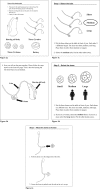Assembly and insertion of a self-fitting hearing aid: design of effective instruction materials
- PMID: 22389434
- PMCID: PMC4040842
- DOI: 10.1177/1084713811430837
Assembly and insertion of a self-fitting hearing aid: design of effective instruction materials
Abstract
A self-fitting hearing aid has been proposed as a viable option to meet the need for rehabilitation in areas where audiology services are unreliable. A successful outcome with a self-fitting hearing aid pivots in part on the clarity of the instructions accompanying the device. The aims of this article are (a) to review the literature to determine features that should be incorporated into written health-care materials and factors to consider in the design process when developing written instructions for a target audience of older adults and (b) to apply this information to the development of a set of written instructions as the first step in self-fitting of a hearing aid, assembling four parts and inserting the aid into the ear. The method involved a literature review of published peer reviewed research. The literature revealed four steps in the development of written health-care materials: planning, design, assessment of suitability, and pilot testing. Best practice design principles for each step were applied in the development of instructions for how to assemble and insert a hearing aid. Separate booklets were developed for the left and right aids and the content of each consisted of simple line drawings accompanied by captions. The reading level was Grade 3.5 equivalent and the Flesch Reading Ease Score was 91.1 indicating that the materials were "very easy" to read. It is essential to follow best practice design principles when developing written health-care materials to motivate the reader, maximize comprehension, and increase the likelihood of successful application of the content.
Conflict of interest statement
Figures
Similar articles
-
Management of hearing aid assembly by urban-dwelling hearing-impaired adults in a developed country: implications for a self-fitting hearing aid.Trends Amplif. 2011 Dec;15(4):196-208. doi: 10.1177/1084713811431694. Epub 2011 Dec 26. Trends Amplif. 2011. PMID: 22200734 Free PMC article.
-
Perception of a self-fitting hearing aid among urban-dwelling hearing-impaired adults in a developed country.Trends Amplif. 2011 Dec;15(4):175-83. doi: 10.1177/1084713811424886. Epub 2011 Nov 10. Trends Amplif. 2011. PMID: 22079900 Free PMC article.
-
Evidence on self-fitting hearing aids.Trends Amplif. 2011 Dec;15(4):215-25. doi: 10.1177/1084713812444009. Epub 2012 Apr 23. Trends Amplif. 2011. PMID: 22528820 Free PMC article. Review.
-
Hearing aid user guides: suitability for older adults.Int J Audiol. 2014 Feb;53 Suppl 1:S43-51. doi: 10.3109/14992027.2013.832417. Epub 2014 Jan 21. Int J Audiol. 2014. PMID: 24447232
-
Quality, Readability, and Suitability of Hearing Health-Related Materials: A Descriptive Review.Am J Audiol. 2020 Sep 3;29(3):513-527. doi: 10.1044/2020_AJA-19-00040. Epub 2020 Jun 18. Am J Audiol. 2020. PMID: 32551926 Review.
Cited by
-
Effectiveness of an online SUpport PRogramme (SUPR) for older hearing aid users: study protocol for a cluster randomised controlled trial.BMJ Open. 2017 Jun 20;7(5):e015012. doi: 10.1136/bmjopen-2016-015012. BMJ Open. 2017. PMID: 28634259 Free PMC article. Clinical Trial.
-
Self-Fitting Hearing Aids: Status Quo and Future Predictions.Trends Hear. 2016 Apr 12;20:2331216516643284. doi: 10.1177/2331216516643284. Trends Hear. 2016. PMID: 27072929 Free PMC article. Review.
-
Evaluating the Safety and Usability of an Over-the-Counter Medical Device for Adults With Mild to Moderate Hearing Loss: Formative and Summative Usability Testing.JMIR Hum Factors. 2025 Jan 20;12:e65142. doi: 10.2196/65142. JMIR Hum Factors. 2025. PMID: 39834141 Free PMC article.
-
Pilot Comparison of Adjustment Protocols of Personal Sound Amplification Products.Semin Hear. 2019 Feb;40(1):26-36. doi: 10.1055/s-0038-1676781. Epub 2019 Feb 5. Semin Hear. 2019. PMID: 30728647 Free PMC article. Review.
-
Outcomes With a Self-Fitting Hearing Aid.Trends Hear. 2018 Jan-Dec;22:2331216518768958. doi: 10.1177/2331216518768958. Trends Hear. 2018. PMID: 29716438 Free PMC article.
References
-
- Albright J., de Guzman C., Acebo P., Paiva D., Faulkner M., Swanson J. (1996). Readability of patient education materials: implications for clinical practice. Applied Nursing Research, 9, 139-143 - PubMed
-
- Australian Institute of Health and Welfare. (2005). Vision problems among older Australians. Retrieved from http://www.aihw.gov.au/publications/aus/bulletin27/bulletin27.pdf
Publication types
MeSH terms
LinkOut - more resources
Full Text Sources
Medical


